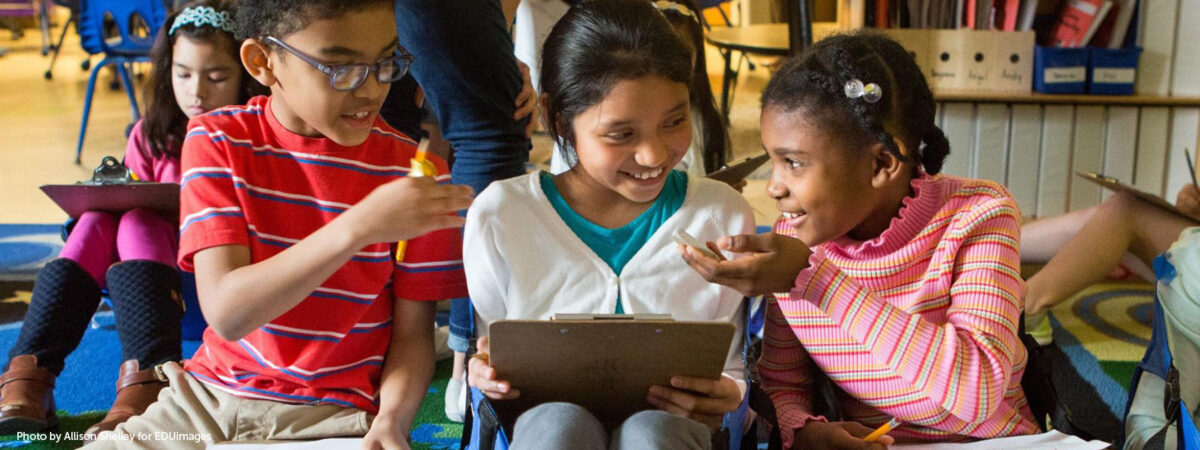
September 7, 2023 | By Dr. Jennifer Stillman
One classroom factor that has been linked to a stronger sense of belonging is mutual respect among students and peer support (Anderman, 2003; Allen et.al, 2018). A potential way to foster mutual respect and peer support is to introduce students to the idea of learner variability, which is the recognition that each learner has a unique constellation of strengths and challenges that are interconnected across the whole child and vary by context (Pape, 2018). Digital Promise’s Learner Variability Project (LVP) hypothesizes that teaching students about learner variability will increase both self-understanding and the understanding and acceptance of others, and results from a recent DonorsChoose study suggest that this may be the case.
In the spring of 2023, LVP partnered with DonorsChoose to introduce our Guide to Teaching Students About Learner Variability to interested teachers, and to gather information about the effectiveness of sharing the ideas of learner variability directly with students. The guide includes sample lesson plans for how to teach students about their own learner variability and that of their classmates across four domains: academic content, social and emotional learning, cognition, and personal background. The 500 teachers who participated in this pilot were encouraged to use these lesson plans with their students and then take a survey to share their feedback on the experience.
Our overall survey results showed that 92% of teachers agreed or strongly agreed that they gained confidence in their ability to support the whole child after using our Guide to Teaching Students About Learner Variability, allowing them to effectively translate the concept to their students; 97% of teachers noticed a positive difference in their classrooms. The most commonly noticed positive change, at 64 %of respondents, was that students were more respectful of the learning or behavioral differences in their classmates, a sentiment which is tied to better understanding and acceptance of their peers, supporting a sense of belonging.
The sample learner variability lessons provided in our guide seemed to provide the right level of entry for explaining learning science to kids. An elementary school teacher described a student who, after participating in the lesson, was able to articulate his own learning connections across a whole child framework saying, “If the bus is late and I’m in a bad mood, I can’t focus on my morning work.”
Another elementary teacher underscored that the idea of learner variability strongly resonated with her students, noting, “My students loved making the ‘I am Unique’ body! They thought it was very cool that they all answered the same questions but that everyone was completely different. I have noticed a change in my students since this lesson as they all realized that they are truly all different in every way and that none of them are exactly the same!”
A middle school teacher observed a similarly positive reaction from her students when she altered her lesson plans based on what she learned about her students from the Guide’s “Create a Character” activity. She describes how she “… provided the students a sense of belonging as they became aware that I was focused on how they learn best, and that I wanted to use this information to plan further instruction based on their needs and adaptability to certain styles of lessons,” setting an example for her students of how understanding each other can translate into a tangible climate shift in the classroom.
Our Guide to Teaching Students About Learner Variability is free and available to all teachers and helps facilitate a better understanding of the learning process and learner variability for both teachers and students, laying the groundwork for a classroom that fosters a sense of belonging. You can also learn more about fostering a Sense of Belonging on the Learner Variability Navigator. If you are interested in arranging professional development to support your school community’s understanding of learner variability, please contact Jessica Jackson at jjackson@digitalpromise.org for more information.
View task directions and sample lesson plans
See key findings
Anderman, L. H. (2003). Academic and social perceptions as predictors of change in middle school students’ sense of school belonging. The journal of experimental education, 72(1), 5-22.
Gillen-O’Neel, C., & Fuligni, A. (2013). A longitudinal study of school belonging and academic motivation across high school. Child Development, 84(2), 678–692. doi:10.1111/j.1467-8624.2012.01862.
Pape, B. (2018). Learner Variability is the Rule, Not the Exception. Digital Promise.
Pittman, L. D., & Richmond, A. (2007). Academic and psychological functioning in late adolescence: the importance of school belonging. Journal of Experimental Education, 75, 275–290.
PISA 2018 Results (Volume III) : What School Life Means for Students’ Lives, “Chapter 9. Sense of belonging at school.”
By Jeremy Roschelle, John Whitmer and Peter Bull
By Adrianna S. and Kyrie F.